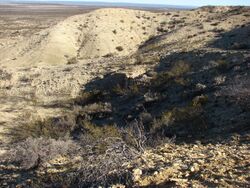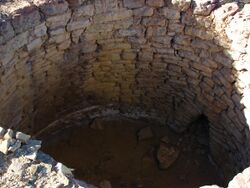Earth:Roca Formation, Argentina

The Roca Formation is a lithostratigraphic unit, located in the Neuquén Basin. It outcrops in the Argentinian provinces of Río Negro, Neuquén, La Pampa, and Mendoza.[1] Its deposition is diachronous, beginning during the Maastrichtian in the north of its distribution, and later moving to the south, where its strata reached the Late Danian. It lies transitionally above the Jagüel Formation, and the top of the formation is marked by a regional unconformity due to an Eocene and Oligocene orogenic pulse. These two units belong to the Malargüe Group. The marine sediments of the Jagüel and Roca formations were deposited during a transgression from the Atlantic Ocean, beginning in the Maastrichtian and ending in the Danian.[2][3]
The stratotype of the Roca Formation is located 12 km (8 mi) north of General Roca, Río Negro (39º40´S, 67º32´W). The fossiliferous beds of the Roca Formation were discovered by G. Rohde Windhausen (1914), who was also the first author to describe these sediments. Schiller (1922) took samples of one section along the Zanjón Roca, from the northern part of General Roca to Horno de Cal (lime kiln). This author proposed to name the lime kiln as the "classic area", and the westward cliffs from the lime kiln as the "model area" of these beds. The lithological composition of this type locality contains gray-yellowish and highly fossiliferous limestones, with greenish claystones and marls, and abundant gypsum at the top. The basal and middle sections are approximately 26 m thick (Weber, 1972).[4]
Lithology
In its type locality, the Roca Formation is divided into three sections. The first section, that is, the base, is approximately 20 m thick (66 ft). It consists of intercalated bioclastic limestones and green claystones.[5] The calcareous materials are highly fossiliferous with textures like wackestone and packstone without an obvious orientation of the shells. The claystones are composed of montmorillonite with calcite and quartz.[6] The second section (middle) is not over 8 m thick (26 ft) and consists mainly of limestones. Such section has very thin strata of varied yellow limestones and siltstones, interbedded with yellow porous and coarse-grained limestones. The limestones of the middle section are almost devoid of fossil invertebrates. The third section (upper) is 25–30 m thick (82–98 ft). It is mainly composed of white gypsum in large crystals. It has lenticular intercalations of greenish siltstones with wave-formed ripples and fragments of gypsum.[6]
The faunal character on the fossils of marine invertebrates in the Roca Formation suggests a transgression from the Atlantic Ocean. By contrast, the marine invasions in Argentina and Chile during the Jurassic and Early Cretaceous were caused by an inflow of seawater from the Pacific Ocean.[7][2]
Discovery of fossils
The first section of the Roca Formation has abundant fossiliferous content, including bivalves, gastropods, bryozoans, echinoderms, crustaceans, ostracods, foraminifera, and calcareous nanoplankton, as well as remains of fish.[4][6][7]
Bivalves
Pycnodonte (Phygraea) burckhardti (Boehm),
Pycnodonte (Phygraea) sarmientoi Casadío 1998,
Gryphaeostrea callophyla (Ihering),
Ostrea wilckensi Ihering,
Ostrea neuquena Ihering,
Cubitostrea ameghinoi (Ihering),
Nucula (Leionucula) dynastes Ihering,
Neilo cf. N. ornata (Sowerby),
Cucullaea rocana Ihering,
Chlamys patagonensis negroina Ihering,
Musculus rionegrensis (Ihering),
Arca ameghinorum Ihering (=Venericardia ameghinorum),
Venericardia iheringi (Boehm),
V. feruglioi Petersen,
Aphrodina burckhardti (Ihering),
Gastropods
“Aporrhais” spp.,
Turritella Turritella burckhardti Ihering,
Turritella aff. T. malaspina Ihering,
Nautoloids
Hercoglossa romeroi (Ihering),
Cimomia camachoi Masiuk,
Decapods
Callianassa burckhardti Boehm,
Echinoida
Linthia joannisboehmi Oppenheim,
Nucleopygus salgadoi Parm
References
- ↑ Rodríguez, María Fernanda (2011). "El Grupo Malargüe (Cretácico Tardío-Paleógeno Temprano) en la Cuenca Neuquina". Relatorio del XVIII Congreso Geológico Argentino (Neuquén).
- ↑ 2.0 2.1 Archuby, Fernando; Salgado, Leonardo; Brezina, Soledad; Parras, Ana (2016). "Dos orillas, dos mundos: Paleontología del Alto Valle del río Negro". El Ojo del Cóndor 7: 10–15. https://ri.conicet.gov.ar/handle/11336/44469.
- ↑ Malumián, Norberto; Náñez, Carolina (2011). "The Late Cretaceous–Cenozoic transgressions in Patagonia and the Fuegian Andes: foraminifera, palaeoecology, and palaeogeography". Biological Journal of the Linnean Society 103 (2): 269–288. doi:10.1111/j.1095-8312.2011.01649.x.
- ↑ 4.0 4.1 del Río, Claudia; Conchero, Andrea; Martínez, Sergio A. (2011). "The Maastrichtian – Danian at General Roca (Patagonia, Argentina): a reappraisal of the chronostratigraphy and biostratigraphy of a type locality". Neues Jahrbuch für Geologie und Paläontologie, Abhandlungen 259/2: 129–156.
- ↑ Kiessling, Wolfgang; Scasso, Roberto; Aberhan, Martin; Ruiz, Lucas; Weidemeyer, Sven (2006). "A Maastrichtian microbial reef and associated limestones in the Roca Formation of Patagonia (Neuquén Province, Argentina)". Fossil Record 9 (2): 183–197. doi:10.1002/mmng.200600007.
- ↑ 6.0 6.1 6.2 Rodríguez, María F.; Leanza, Héctor A.; Salvarredy Aranguren, Matías (2007). Hoja Geológica 3969-II - Neuquén. Servicio Geológico Minero Argentino - Instituto de Geología y Recursos Minerales. ISSN 0328-2333. https://www.researchgate.net/publication/263009433.
- ↑ 7.0 7.1 Aguirre-Urreta, M.B., S. Casadío, M. Cichowolski, D.G. Lazo y D.L. Rodríguez, 2008. Afinidades paleobiogeográficas de los invertebrados cretácicos de la Cuenca Neuquina. Ameghiniana 45 (3): 593-613.
External links
 |



